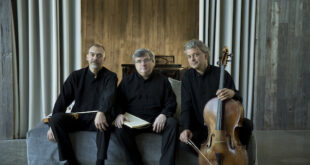For 1,500 years Hagia Sophia has stood in the heart of the city once known as Constantinople, today’s Istanbul. The world’s largest building at the time of construction, and the world’s largest cathedral for nearly a thousand years, it was the pinnacle of Byzantine architecture, and the avatar of that empire’s vast cultural and political influence.

During Hagia Sophia’s centuries as the seat of Eastern Orthodoxy, its 55-meter-high central dome would ring with devotional chant. It sounded unlike any other music in the world. The voices would reverberate for some 12 seconds, four or five times longer than in a modern concert hall. Sound would rise to the dome, fall back, echo and resound off the marble walls. But for the past half millennium, no one had heard this music sound this way.
In the 15th century the Ottoman Turks conquered Constantinople and turned the great cathedral into a mosque, where liturgical music wasn’t part of the worship tradition. And when Kemal Ataturk established the modern secular state of Turkey in the 1930s, Hagia Sophia became a museum, one that does not host musical performances.

Stanford University art historian Bissera V. Pentcheva wanted to know what that ancient music sounded like. Manuscripts exist, but the music couldn’t be performed in anything resembling the space inside Hagia Sophia. And it was impossible to stage a choir performance inside the legendary building itself.
So, beginning in 2008, Pentcheva teamed up with Jonathan Abel of the Center for Computer Research in Music and Acoustics. Together with the choir Cappella Romana, which specializes in Byzantine chant and other early music, they created the Icons of Sound project to use digital technology to recreate the sound of the music of those times in that unique place.

The researchers started with a simple recording of a balloon popping inside Hagia Sophia. Later they took measurements with an array of special microphones, enabling them to digitize and reproduce the behavior of sound waves emanating from the ancient choirs’ original position inside the church.
Applying this digital information to live performances by Cappella Romana of Byzantine liturgical music at Stanford’s Bing Hall, they have created an “auralization” that’s now available on the new CD/Blu-ray release Lost Voices of Hagia Sophia.
Described at “the first vocal album in the world to be recorded entirely in live virtual acoustics,” it’s like nothing you’ve ever heard.
The accompanying booklet includes essays by Pentcheva; by Cappella Romana’s founder and musical director Alexander Lingas on the genesis, meaning, and technical aspects of the musical selections themselves; and by Abel and Elliot K. Canfield-Dafilou on the way they accomplished the auralization.
Lingas’s liner notes give historical and musicological background for each of the pieces of music. The booklet even has an image of a page of original notation, with a “translation” into Western musical notation.
These chants were written and performed for a variety of rituals, with the practices and the music evolving over the centuries, a history Lingas goes into in some detail.
They are properly termed chants, but they will surprise listeners expecting something like the Gregorian chants familiar to the world of Western Christianity and pop culture. Some melodic lines are sung with droning accompaniment. Female voices took part in Eastern Orthodox chants in Hagia Sophia and are present on the recording. You’ll hear fast-moving melismas, as well as chants of nonsense syllables called vocables, or, in the Greek of the chants, teretismata.
Both Lingas and Pentcheva draw on the meanings of the Greek terms of the Orthodox liturgy to make observations both trenchant and, in Pentcheva’s case, sometimes a little fanciful. The Blu-ray includes, along with one additional track that didn’t fit on the CD, a 20-minute “making of” documentary that I found absolutely fascinating.
Thanks to Pentcheva’s poeticizing, it’s evocative too. She points out, for example, that Hagia Sophia’s original decor had no human imagery. (During some periods of the Byzantine Empire, icons were considered idolatry. The issue caused much strife and even violence before it was at last settled.) Instead, only vegetal and geometric designs graced the interior surfaces. Experience of the divine was communicated through sonic means, and for this the tremendous church was ideally suited.
The final piece on the CD is the “Asmatikon Cherubic Hymn.” “Cherubic” reflects the idea that the choir was meant to evoke the divine by literally sounding like a heavenly choir of angels.
Gregorian chants have an austere beauty. (Listen, for example, to the Choir of the Vienna Hofburgkapelle’s classic recordings.) But they sound like a small band of humble men singing solemn prayers in unison, not a heavenly host of singers. Cappella Romana’s remarkable revival of the “lost voices” of Hagia Sophia is a revelation in both sonic and artistic terms. I can only imagine its impact on an observant Eastern Orthodox churchgoer.
But you need bring to this recording no religious feeling, nor any familiarity with any particular tradition, to appreciate and enjoy it immensely for its sheer musical beauty. If you’re already interested in ancient music in general, or in Byzantine culture and history, that will only enhance your appreciation further. The CD+Blu-ray box and an MP3 download version are available now via the Cappella Romana website.
 Blogcritics The critical lens on today's culture & entertainment
Blogcritics The critical lens on today's culture & entertainment




